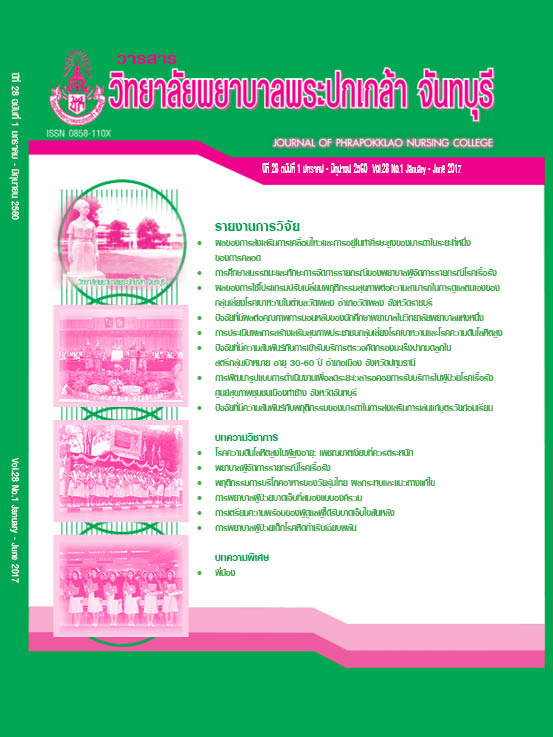Factors Affecting Sleep Quality among Nursing Students in One College of Nursing
Keywords:
Sleep quality, Environment, Sleep habit, StressAbstract
The purposes of this predictive research were to examine factors affecting sleep quality among nursing students. The samples consisted of 150 1st - 3rd year nursing students in one College of Nursing, in an academic year of 2014. The research instruments consisted of a questionnaire of personal factors, an assessment form of environmental factors with the reliability of .70, an assessment form of sleep habits with the reliability of .70, Suanprung Stress Test with the reliability of .91, and the Thai version of the Pittsburgh Sleep Quality Index with the reliability of .70. Data were collected from September to November, 2014. Statistics used for data analysis included frequency, percentage, mean, standard deviation, Chi-square test, Pearson’s product moment correlation, and stepwise multiple regression.
The results revealed that 1) most of the nursing students had average scores of environmental factors, sleep habits, and stress at the moderate level (58%, 52%, and 47.30%, respectively); 2) most of the nursing students had a poor sleep quality (78%); 3) the factors statistically significant related to sleep quality were as follows—environmental factors (r = .307, p < .001), sleep habits (r = .166, p < .05), and stress (r = .299, p < .001), and 4) environmental factors, sleep habits, and stress could co-predict sleep quality by 17.40% (R2 = .174, p < .01).
This study suggested that in order to promote sleep quality of nursing students, the modification of dormitory environment, the enhancement of good sleep habits, and stress management should be taken into consideration.
References
กันตพร ยอดใชย, อารีย์วรรณ อ่วมตานี, และทิพมาส ชิณวงศ์. (2550). ปัจจัยที่ทำนายคุณภาพการนอนหลับของพยาบาลในโรงพยาบาลศูนย์ภาคใต้. สงขลานครินทร์เวชสาร, 25(5), 407-413.
จิตรา สุขเจริญ, และสุวรรณา วุฒิรณฤทธิ์. (2551). ปัจจัยที่มีผลต่อความเครียดและการเผชิญความเครียดของนักศึกษาพยาบาล วิทยาลัยพยาบาลบรมราชชนนี ชลบุรี (รายงานผลการวิจัย). วิทยาลัยพยาบาลบรมราชชนนี ชลบุรี.
จินดารัตน์ ชัยอาจ. (2556). ปัจจัยที่รบกวนการนอนหลับในโรงพยาบาล: การจัดการโดยไม่ใช้ยา. พยาบาลสาร, 40(พิเศษ), 105-115.
จิราภรณ์ ทับแสงสี. (2550). คุณภาพการนอนหลับของพยาบาลประจำการ หออภิบาลผู้ป่วยหนักในประเทศไทย (วิทยานิพนธ์ปริญญามหาบัณฑิต). กรุงเทพฯ: จุฬาลงกรณ์มหาวิทยาลัย.
ฉันทนา แรงสิงห์. (2550). คุณภาพการนอนหลับและภาวะสุขภาพจิตของพยาบาลวิชาชีพ ในโรงพยาบาลรัฐ เขตกรุงเทพมหานคร (วิทยานิพนธ์ปริญญามหาบัณฑิต). กรุงเทพฯ: จุฬาลงกรณ์มหาวิทยาลัย.
ชลธิชา แย้มมา, และพีรพนธ์ ลือบุญธวัชชัย. (2556). ปัญหาการนอนหลับ ความเหนื่อยล้า และประสิทธิภาพในการปฏิบัติงานของพยาบาลวิชาชีพในโรงพยาบาลจุฬาลงกรณ์. วารสารสมาคมจิตแพทย์แห่งประเทศไทย, 58(2), 183-196.
ณภัทรารัตน์ ขาวสอาด, มณี อาภานันทิกุล, และพรรณวดี พุธวัฒนะ. (2556). ปัจจัยคัดสรรที่มีความสัมพันธ์กับความสุขของนักศึกษาพยาบาล. วารสารสภาการพยาบาล, 28(1), 19-33.
ตะวันชัย จิรประมุขพิทักษ์, และวรัญ ตันชัยสวัสดิ์. (2540). ปัญหาคุณภาพการนอนหลับของพยาบาลประจำการ โรงพยาบาลสงขลานครินทร์. วารสารสมาคมจิตแพทย์แห่งประเทศไทย, 42(3), 123-132.
นงลักษณ์ ทัศเกตุ. (2550). คุณภาพการนอนหลับและปัจจัยรบกวนการนอนหลับในผู้ป่วยกระดูกหักที่ได้รับการผ่าตัดในหอผู้ป่วยพิเศษ โรงพยาบาลเชียงใหม่ราม (วิทยานิพนธ์ปริญญามหาบัณฑิต). มหาวิทยาลัยเชียงใหม่.
ผู้จัดการออนไลน์. (2557). เลื่อนเวลานาฬิกาปลุก เสี่ยงสมาธิสั้น ความจำย่ำแย่. สืบค้น วันที่ 20 พฤศจิกายน 2557, จาก https://blog.eduzones.com/snowytest/126299
วันเพ็ญ ไสยมรรคา. (2555). ปัจจัยที่มีความสัมพันธ์กับความกลัวการคลอดของมารดาในระยะที่ 1 ของการคลอด. วารสารพยาบาลและสุขภาพ, 35(2), 34-42.
วิชิต อู่อ้น. (2550). การวิจัยและการสืบค้นข้อมูลทางธุรกิจ. กรุงเทพฯ: พรินท์แอทมี.
สุจินดา ริมศรีทอง, สุดาพรรณ ธัญจิรา, และอรุณศรี เตชัสหงส์. (บ.ก.). (2550). พยาธิสรีรวิทยาทางการพยาบาล เล่ม 1 (พิมพ์ครั้งที่ 2). กรุงเทพฯ: สามเจริญพาณิชย์.
สุดารัตน์ ชัยอาจ, จิราภรณ์ เตชะอุดมเดช, พิกุล บุญช่วง, และวิจิตร ศรีสุพรรณ. (2550). คุณภาพการนอนหลับและปัจจัยที่รบกวนการนอนหลับของผู้ป่วยในหอผู้ป่วยอายุรกรรม โรงพยาบาลมหาราชนครเชียงใหม่. วารสารสภาการพยาบาล, 22(4), 50-63.
สุวัฒน์ มหัตนิรันดร์กุล, วนิดา พุ่มไพศาลชัย, และพิมพ์มาศ ตาปัญญา. (2540). การสร้างแบบวัดความเครียดของสวนปรุง (รายงานผลการวิจัย). เชียงใหม่: โรงพยาบาลสวนปรุง.
อนุชา คำส้อม, มธุรส ทิพยมงคลกุล, สิริมา มงคลสัมฤทธิ์, และวิสาข์สิริ ตันตระกูล. (2558). ความชุกและปัจจัยที่มีความสัมพันธ์กับปัญหาการนอนหลับของบุคลากรในโรงพยาบาล. สืบค้น วันที่ 6 มิถุนายน 2560, จาก http://phep.ph.mahidol.ac.th/thai/presentation_2558.html
Bahammam, A. S., Alaseem, A. M., Alzakri, A. A., Almeneessier, A. S., & Sharif, M. M. (2012). The relationship between sleep and wake habits and academic performance in medical students: A cross-sectional study. BMC Medical Education, 12(1), 61.
Bailer, J., Schwarz, D., Witthöft, M., Stübinger, C., & Rist, F. (2008). Prevalence of mental disorders among college students at a German university. Psychotherapie, Psychosomatik, Medizinische Psychologie, 58(11), 423-429.
Cain, N., & Gradisar, M. (2010). Electronic media use and sleep in school-aged children and adolescents: A review. Sleep Medicine, 11(8), 735-742.
Fawzy, M., & Hamed, S. A. (2017). Prevalence of psychological stress, depression and anxiety among medical students in Egypt. Psychiatry Research, 225, 186-194.
Gradisar, M., Wolfson, A. R., Harvey, A. G., Hale, L., Rosenberg, R., & Czeisler, C. A. (2013). The sleep and technology use of Americans: Findings from the National Sleep Foundation’s 2011 Sleep in America Poll. Journal of Clinical Sleep Medicine, 9(12), 1291-1299.
Hayley, A. C., Williams, L. J., Venugopal, K., Kennedy, G. A., Berk, M., & Pasco, J. A. (2015). The relationships between insomnia, sleep apnoea and depression: Findings from the American National Health and Nutrition Examination Survey, 2005-2008. Australian & New Zealand Journal of Psychiatry, 49(2), 156-170.
Hershner, S. D., & Chervin, R. D. (2014). Causes and consequences of sleepiness among college students. Nature and Science of Sleep, 6, 73-84.
Huang, Y. S., Wang, C. H., & Guilleminault, C. (2010). An epidemiologic study of sleep problems among adolescents in North Taiwan. Sleep Medicine, 11(10), 1035-1042.
Lim, D. K., Baek, K. O., Chung, I. S., & Lee, M. Y. (2014). Factors related to sleep disorders among male firefighters. Annals of Occupational and Environmental Medicine, 26, 11.
Lockley, S. W., et al. (2007). Effects of health care provider work hours and sleep deprivation on safety and performance. Joint Commission Journal on Quality and Patient Safety, 33(Suppl. 11), 7-18.
Lund, H. G., Reider, B. D., Whiting, A. B., & Prichard, J. R. (2010). Sleep patterns and predictors of disturbed sleep in a large population of college students. Journal of Adolescent Health, 46(2), 124-132.
Luo, J., et al. (2013). Prevalence and risk factors of poor sleep quality among Chinese elderly in an urban community: Results from the Shanghai Aging Study. PLoS One, 8(11), e81261.
Montagna, P., & Chokroverty, S. (Eds.). (2011). Handbook of clinical neurology: Sleep disorder, Part 1. Edinburgh: Elsevier.
Morin, C. M. (2009). Foreword. In Silberman, S. A. The insomnia workbook: A comprehensive guide to getting the sleep you need. Oakland, CA: New Harbinger Publications.
Schlarb, A. A., Claßen, M., Hellmann, S. M., Vögele, C., & Gulewitsch, M. D. (2017). Sleep and somatic complaints in university students. Journal of Pain Research, 10, 1189-1199.
Taylor, D. J., & Bramoweth, A. D. (2010). Pattern and consequences of inadequate sleep in college students: Substance use and motor vehicle accidents. Journal of Adolescent Health, 46(6), 610-612.
Downloads
Published
How to Cite
Issue
Section
License
Copyright (c) 2017 Journal of Phrapokklao Nursing College

This work is licensed under a Creative Commons Attribution-NonCommercial-NoDerivatives 4.0 International License.
เนื้อความ ข้อมูล และรายการอ้างอิงที่ผู้เขียนใช้ในการเขียนบทความเพื่อลงตีพิมพ์ในวารสารวิทยาลัยพยาบาลพระปกเกล้า จันทบุรี ถือเป็นความคิดเห็นและความรับผิดชอบของผู้เขียน คณะผู้จัดทำวารสารไม่จำเป็นต้องเห็นพ้องด้วยหรือร่วมรับผิดชอบ
บทความที่ได้รับการลงตีพิมพ์ในวารสารวิทยาลัยพยาบาลพระปกเกล้า จันทบุรี ถือเป็นลิขสิทธิ์ของวารสารวิทยาลัยพยาบาลพระปกเกล้า จันทบุรี หากหน่วยงานหรือบุคคลใดต้องการนำส่วนหนึ่งหรือทั้งหมดของบทความไปเผยแพร่ต่อเพื่อวัตถุประสงค์ใด ๆ จะต้องได้รับอนุญาตจากบรรณาธิการวารสารก่อน



